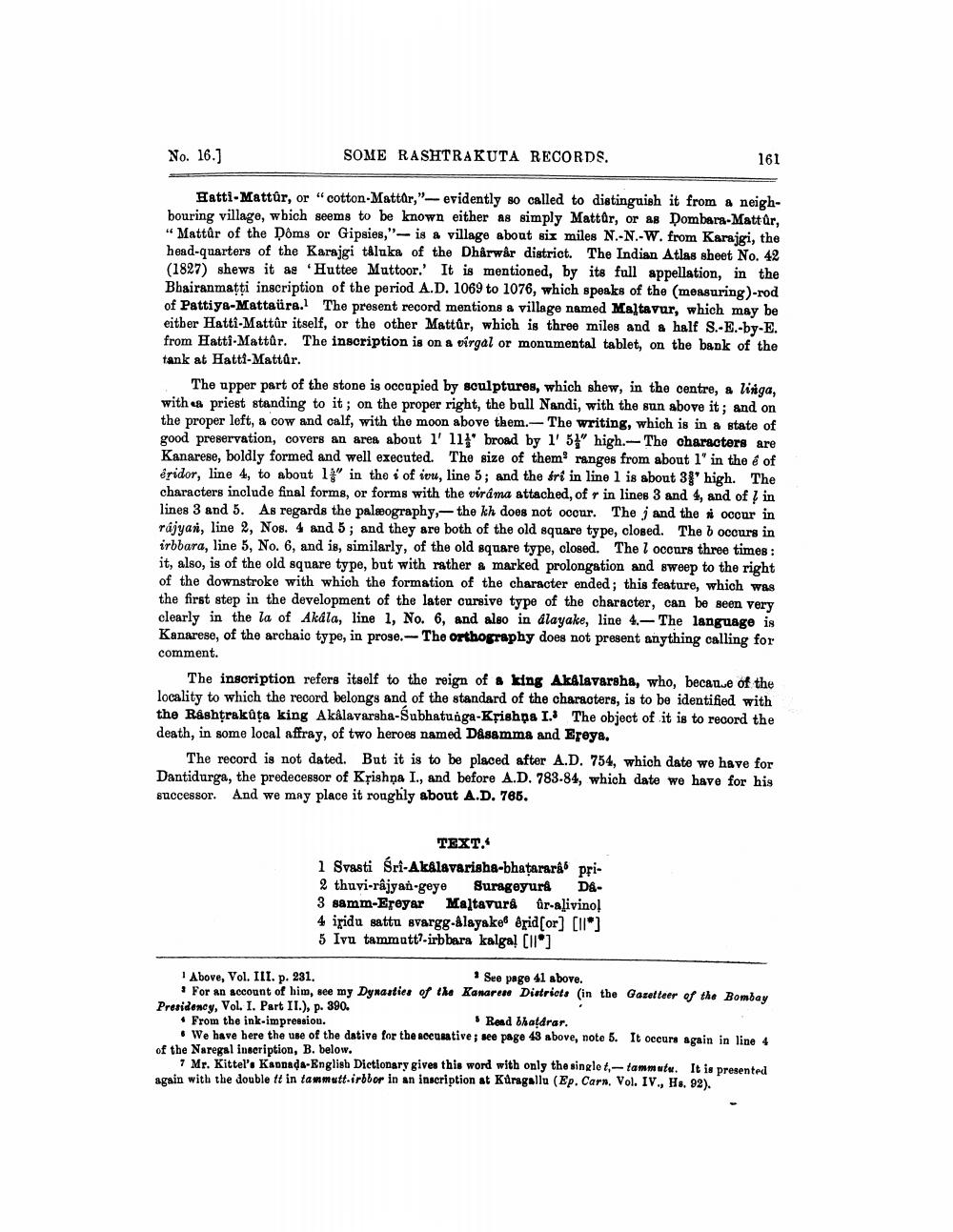________________
No. 16.)
SOME RASHTRAKUTA RECORDS.
161
Fatti-Mattûr, or "cotton-Mattar, "-evidently so called to distinguish it from a neighbouring village, which seems to be known either as simply Mattûr, or as Dombara-Mattur, "Mattar of the Doms or Gipsies," -- is a village about six miles N.-N.-W. from Karajgi, the head-quarters of the Karajgi taluka of the Dharwår district. The Indian Atlas sheet No. 42 (1827) shews it as Huttee Muttoor.' It is mentioned, by its full appellation, in the Bhairanmatti inscription of the period A.D. 1069 to 1076, which speaks of the measuring)-rod of Pattiya-Mattaüra. The present record mentions a village named Maltavur, which may be either Hatti-Mattûr itself, or the other Mattûr, which is three miles and a half S.-E.-by-E. from Hatti-Mattûr. The inscription is on a virgal or monumental tablet, on the bank of the tank at Hatti-Mattår.
The upper part of the stone is occupied by sculptures, which shew, in the centre, & linga, with a priest standing to it; on the proper right, the bull Nandi, with the sun above it; and on the proper left, a cow and calf, with the moon above them. The writing, which is in a state of good preservation, covers an area about l' ll}' broad by 1' 5" high. The characters are Kanarese, boldly formed and well executed. The size of them ranges from about 1' in the of éridor, line 4, to about 13" in the i of ivu, line 5; and the fri in line 1 is about 38' high. The characters include final forms, or forms with the viráma attached, of r in lines 3 and 4, and of in lines 3 and 5. As regards the palæography,- the kh does not occur. The j and the occur in rajyari, line 2, Nos. 4 and 5; and they are both of the old square type, closed. The b occurs in irbbara, line 5, No. 6, and is, similarly, of the old square type, closed. The l occurs three times : it, also, is of the old square type, but with rather & marked prolongation and sweep to the right of the downstroke with which the formation of the character ended; this feature, which was the first step in the development of the later cursive type of the character, can be seen very clearly in the la of Akala, line 1, No. 6, and also in dlayake, line 4.-The language is Kanarese, of the archaic type, in proge. The orthography does not present anything calling for comment.
The inscription refers itself to the reign of a king Akalavarsha, who becane of the locality to which the record belongs and of the standard of the characters, is to be identified with the Rashtrakūta king Akalavarsha-Subhatunga-Křishpa I. The object of it is to record the death, in some local affray, of two heroes named Disamma and Eroya.
The record is not dated. But it is to be placed after A.D. 754, which date we have for Dantidurga, the predecessor of Krishna I., and before A.D. 783-84, which date we have for his successor. And we may place it roughly about A.D. 765.
TEXT. 1 Svasti śri-Akalavarisha-bhatarar&6 pri2 thuvi-rajyan-geye Surageyurt De3 samm-Eroyar Maltavura Ar-alivino! 4 iridu satta svargg-alayakes erid(or] [II] 5 Ivu tammutti-irbbara kalga! [ll]
Above, Vol. III. p. 281.
See page 41 above. # For an account of him, see my Dynasties of the Kanaren Districts in the Gazetteer of the Bombay Presidency, Vol. 1. Part II.), p. 390. • From the ink-impressiou.
Read bhatdrar. • We have bere the use of the dative for the accusative; see page 43 above, note 5. It occurs again in line 4 of the Naregal inscription, B. below.
7 Mr. Kittel'. Kappada-English Dictionary gives this word with only the single t, -tammutu. It is presented again with the double ft in tammatt.irbbor in an inscription at Kůragallu (Ep. Carn, Vol. IV., H. 92).




